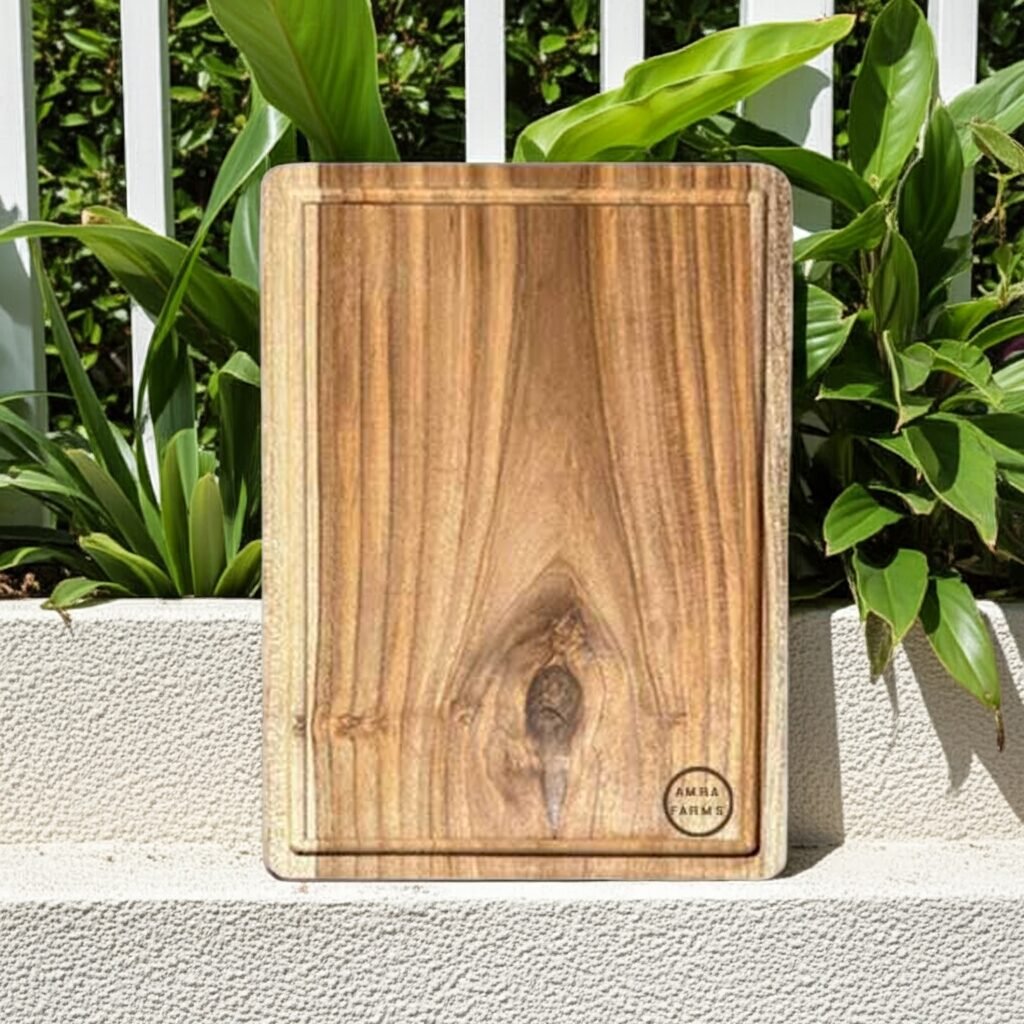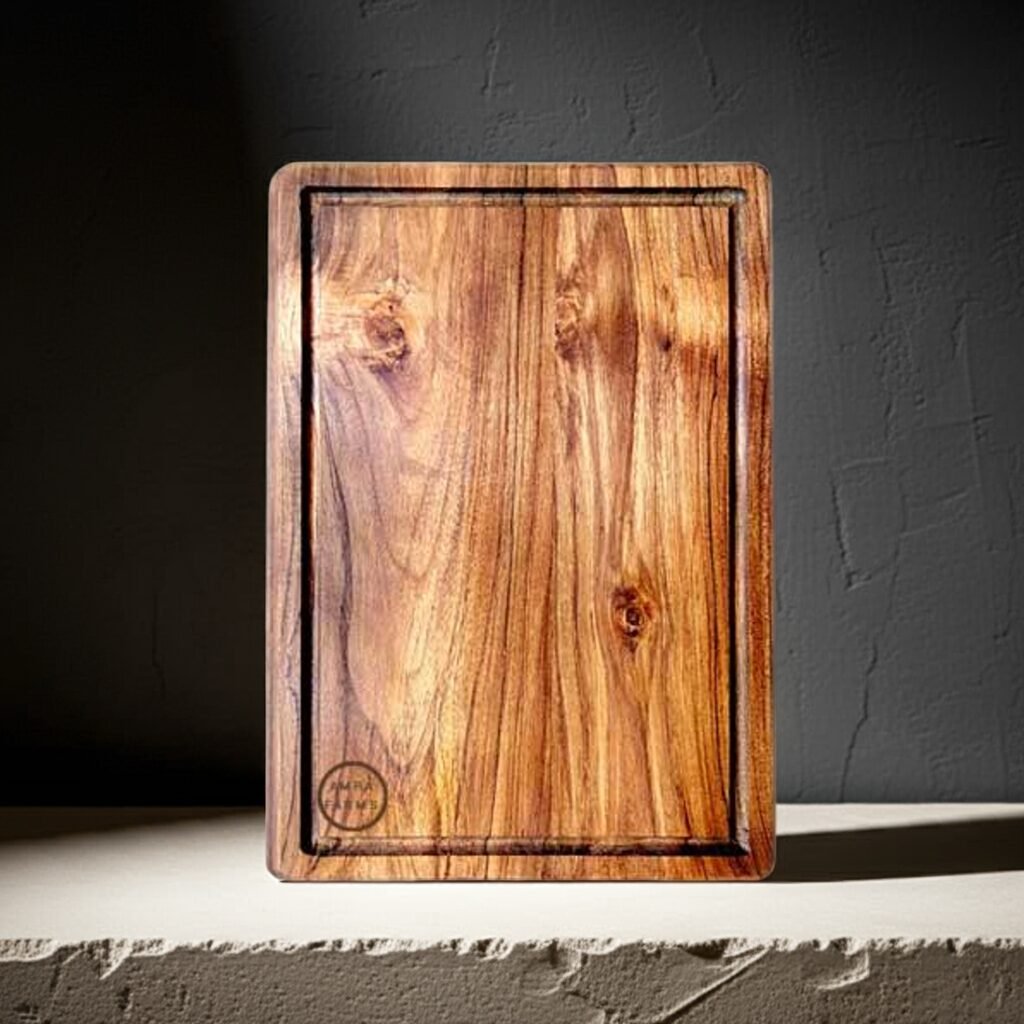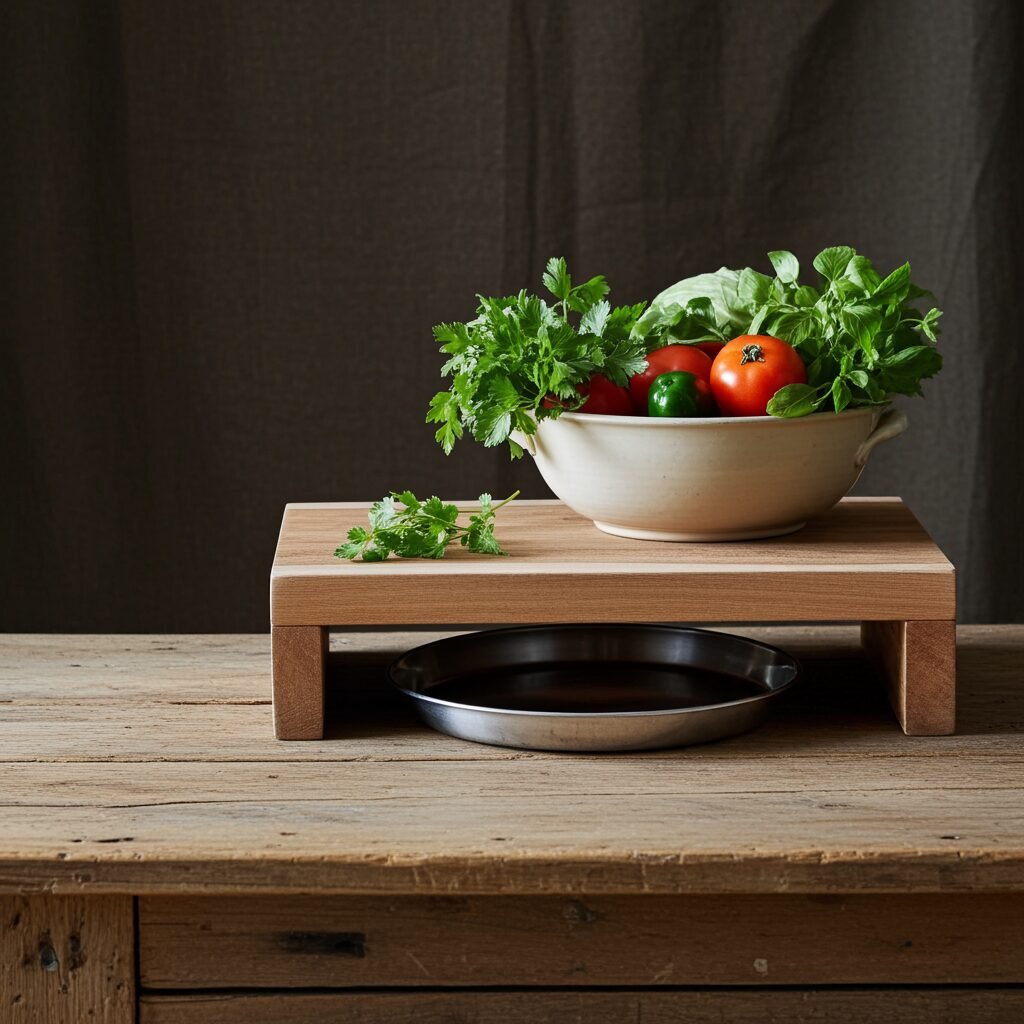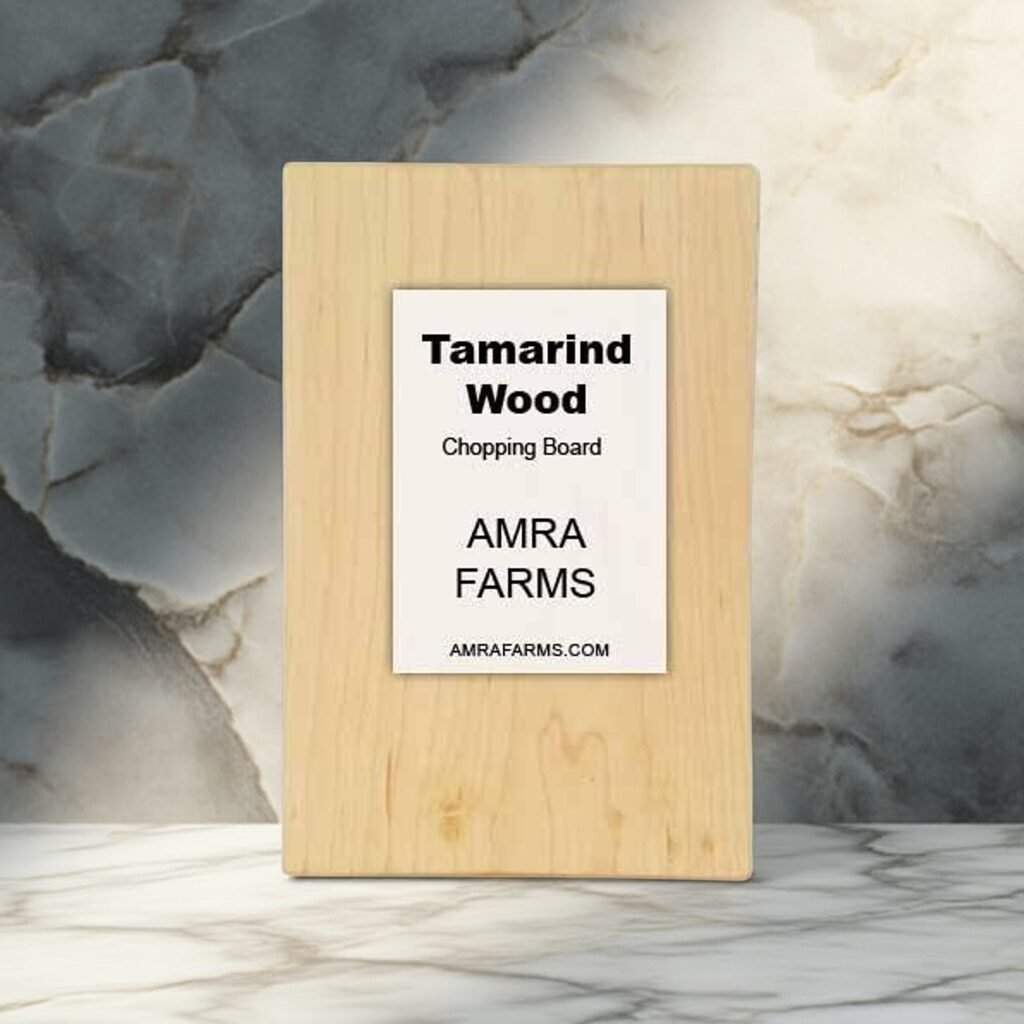Your cart is currently empty!
Wooden chopping boards, the construction and trends that affect your purchase
Wooden chopping boards are a difficult choice due to the varieties of wood available. Different wood types bring in levels of hardness, durability, antibacterial properties, maintenance needs and aesthetic appeal with them. Choosing the right board often requires that you get the combination right. This article compares the most preferred wood for chopping boards based on the trends and performance of wood and what people prefer. The performance comparison and the latest trends may help you choose the perfect board for your kitchen






Core Construction Types (How the board is made)
| Construction | How It’s Built | Typical Thickness | Pros | Cons | Ideal Use |
|---|---|---|---|---|---|
| Edge‑grain (flat‑grain) | Boards are cut parallel to the tree’s growth rings; the grain runs length‑wise across the surface. | 0.75‑1.5 in (≈ 2‑4 cm) | Easy to machine → lower price Good durability for everyday chopping Flat, stable surface | Slightly harder on knives than end‑grain Can warp if not sealed properly | General home cooking, veg‑heavy prep, light meat work |
| End‑grain (reversible) | The board is sliced perpendicular to the growth rings, exposing the ends of the wood fibers (like a “brick wall”). Often made from a single block or from glued‑together strips. | 1‑2 in (≈ 2.5‑5 cm) | “Self‑sharpening” – knife slides between fibers, preserving edge Very gentle on knives Can be flipped (dual‑sided) for raw vs. cooked foods | More expensive (more labor & material) . Heavier, may need a stand or rack | Professional kitchens, serious home cooks, meat‑heavy prep |
| Strip‑laminated (also called “strip‑built”) | Thin strips of wood (often hardwood) are glued together, grain alternating 90° (cross‑laminated) for stability. The surface is then planed smooth. | 0.75‑1.5 in | Very stable, resists warping Can be made from lower‑grade wood → lower cost Often reversible | Glue lines can be visible; some people avoid glue for “pure wood” feel. Slightly less “self‑sharpening” than true end‑grain | Mid‑range home kitchens, budget‑friendly professional settings |
| Solid‑block (single‑piece) | Carved from a single, solid piece of hardwood (e.g., a 12‑in×12‑in×1‑in block). | 1‑2 in | No glue → truly “all‑wood” Very durable, can be heirloom quality | Very heavy Prone to cracking if not sealed evenly Expensive | High‑end kitchens, decorative serving boards |
| Hybrid (wood‑core + protective overlay) | Core of hardwood (often end‑grain) topped with a thin layer of food‑grade polymer or resin for extra sanitation. | 0.75‑1.5 in | Combines knife‑friendliness of wood with easy‑clean surface Often dishwasher‑safe on top layer | More complex manufacturing → higher price Some users dislike the synthetic top layer | Specialty boards for raw meat that need quick sanitizing |
Teak wood chopping boards vs oak – which one lasts longer
Oak is not a very common wood in India. Parts of Asia which includes China, Europe and North America are areas where oak is commonly grown. They are durable wood widely available and reasonably sustainable types of wood. On the contrary, Teak is native to India, sustainable with eco-friendly cultivation practices and the best wood for cutting boards. The biggest reason why Teak is one of the preferred wooden chopping boards is due to its rich oil content. Teak contains 25% more natural oil content than oak boards. The oil content acts as a natural barrier against water absorption, effectively deters bacterial growth, prevents warping and cracking among others. While oak is a durable wood, it lacks the built-in moisture protection features of teak which can reduce the lifespan of a cutting board in a kitchen.
Tamarind wood cutting boards – Stronger & Denser than mango wood
Tamarind is considered one of the toughest woods in India. They are not rich in terms of colours and grains compared to teak, walnut or acacia but are durable, dense and water resistant. The dense fibre composition in tamarind wood restricts water retention while also making it harder. Tamarind wooden chopping boards are 31% harder than mango wood and the density makes it resistant to deep knife marks and cuts. The wear and tear on a tamarind wood is considerably lesser than mango woods. While mango wood is a popular material for chopping boards in Asia due to instant availability and affordability, the durability of tamarind wood cannot be matched with that of mango wood.
Acacia wooden chopping boards are going to be the market favourite
Acacia wooden chopping boards are the new favourite among professional chefs and homeowners. Acacia wooden cutting boards are the most exported cutting boards from India to the United States. They account for 19% of the wooden cutting board market. Known for its rich colour variation, durability and balance in performance and aesthetics, acacia makes a popular mid-range choice. Acacia wood board popularity is due to its sustainability and is marketed as affordable hardwood cutting boards. Acacia is harder than mango but lacks the moisture resistance when compared to teak wood.
End grain vs Flat grain chopping boards – The better choice
End grain chopping boards are considered the gold standard for serious cooks. End grain chopping boards are 2.4 times more resistant to knife marks compared to flat grain boards due to their unique fibre structure. The design allows to self-heal after cutting extending the life of the cutting board significantly. Unfortunately, the price of an end grain cutting board is often 3-4 times that of a regular cutting board which restricts most home users from purchasing them. Premium end grain cutting boards made from teak wood are usually expensive, in the range of 6000-7000 Rs or even higher depending on the design of the board.
Why bamboo boards may not be as durable as hardwood
Bamboo boards are marketed as an eco-friendly sustainable option but they have their own limitations. Bamboo boards are 20% less durable than hardwood chopping boards due to its construction. While lightweight and sustainable, frequent use leads to splitting and faster wear. Bamboo boards are flattened bamboo shoots stuck together with adhesives. When exposed to water frequently they tend to loosen and split. Hardwood on the other hand is a durable kitchen surface which is eco-friendly and tough.
Walnut cutting boards preferences in Indian kitchen
Walnut chopping boards is a luxury kitchenware which dominate the world market. 46% of high-end wooden chopping boards are made from walnut. They are favoured for their dark elegant appearance and soft yet durable texture that is gentle on knives. Premium walnut boards are often imported from China or the United States. The premium tag comes with import costs, duties and other charges including an exorbitant tax making them often far more expensive compared to teak wood and other premium boards. Walnut boards are often sold in India for Rs 1000 or more depending on the construction type and quality of the product.
Maple wood chopping boards – American choice
Maple remains the most widely used chopping boards in North America. They amount to 55% of all boards sold in the USA and Canada. They have a balance of hardness and durability. They are light coloured and favoured by professional cooks and home chefs alike. Maple boards are not preferred in India. Indian boards are mostly made from mango wood and tamarind due to the cost effectiveness and better performance compared to Maple.
Indian Neem wood chopping boards – naturally antibacterial and outshines Oak
Neem is considered sacred and ayurvedic in Indian tradition. For health conscious home owners, Indian neem wood chopping boards offer natural antibacterial properties which is 14% stronger than oak. Neem is a more eco-friendly choice for families and commercial kitchen. Neem wood comes in darker shades are antibacterial and hygienic wooden cutting boards.
Custom composite Wooden boards : It’s trending but is it safe?
New materials are often part of the kitchen industry. Innovative material like custom composite wooden boards saw a rise by 18% in sales in 2024. They are durable and have the ability to blend different wood for unique designs and performance characteristics. Hybrid wooden chopping boards are yet new to the market and performance data is still not available.
Mango wood chopping boards in Asia – The popular choice
34% of all wooden chopping boards are made from mango wood in Asia. Being available readily, sustainable and eco-friendly, mango wood chopping boards are affordable and durable. While not as durable and hard as tamarind or teak, the cost effectiveness for households makes mango wood the desired material for budget friendly home owners. They are functional and considered rustic for a farm house design kitchens. Mango wood chopping boards usually last 5-7 years with proper care.
While maple and walnut wooden boards may be the choice in the USA, Mango wood dominates the market in India. Teak wood chopping boards are considered premium quality boards while end grain chopping boards made from teak and neem are often considered gold standard chopping boards not just in India but worldwide.
Key Construction Details That Influence Purchase
| Detail | Why It Matters | What to Look For |
|---|---|---|
| Wood Species | Hardness, grain pattern, natural antimicrobial compounds, and price vary. | Maple (hard, closed‑grain, classic), Walnut (rich colour, slightly softer), Beech (light, uniform), Teak (oil‑rich, water‑resistant), Tamarind (popular in India), Bamboo (technically grass, harder but more porous). |
| Janka Hardness Rating | Indicates resistance to denting & gouging. Higher = longer life, but may be tougher on knives. | 1,200‑1,500 N (Teak, Tamarind) is a sweet spot. > 1,800 N (harder woods) can dull knives faster. |
| Finish / Oil | Determines water resistance, food safety, and maintenance frequency. | Food grade mineral oil, Coconut oil, or beeswax. Avoid polyurethane, lacquer, or any finish not labeled “food safe”. |
| Thickness | Thicker boards are more stable and less likely to warp, but heavier. | 1 in (≈ 2.5 cm) for end‑grain; 0.75‑1 in for edge‑grain. |
| Reversibility / Double‑sided | Allows separate sides for raw vs. cooked foods, extending board life. | Look for “reversible” or “dual‑side” labeling. |
| Edge Treatment | Rounded edges reduce chipping and are easier on hands; straight edges can be more stable on a countertop. | Choose based on ergonomics and storage preference. |
| Size & Shape | Determines countertop footprint, storage, and suitability for large items (e.g., whole fish). | Common sizes: 12×18 in, 15×20 in, 18×24 in. Specialty shapes (round, oval) for serving. |
| Sustainability Certification | Growing consumer concern for forest stewardship. | FSC (Forest Stewardship Council), PEFC, or “reclaimed wood” labels. |
| Weight & Handling | Heavy boards stay put but may need a stand; lighter boards are portable. | 5‑10 lb for typical 12×18 in edge‑grain; 12‑20 lb for end‑grain. |
| Aesthetic Details | Grain pattern, colour, and any decorative inlays affect kitchen décor. | Natural finish vs. stained; consider whether you’ll also use the board for serving. |
While choosing your next cutting board, consider your options in terms of material with the data you now have!
Categories
Products
- Buy Wooden Vegetable Cutting Boards Online
- Wooden Kitchen Accessories Tools
- Buy Butcher Block & Meat Cutting Boards Online
- Buy Premium Edge Grain Single Block Wooden Chopping Boards Online
- Buy The Best Teak Wood Chopping Boards Online In India
- Buy Wooden Cutting Boards With Handle For Kitchen
- Mango Wood Chopping Boards
- Single Block Chopping Boards
- Tamarind Wood Chopping Boards
- Wooden Platter Boards , Pizza Platters & Charcuterie Boards
Tamarind Wood Cutting Board Teak Wood Cutting board
Recent Posts
- Unique Wooden Chopping Boards with Medicinal Benefits
- Exotic Woods of India and Its Uses
- Best Uses of Teak Wood: Common and Unique Applications That Make It the King of Hardwoods
- What to look for when purchasing a teak wood cutting board and how to identify teak wood
- Wooden chopping boards that naturally resist fungus/mould growth
